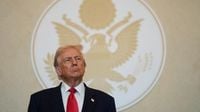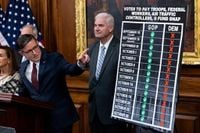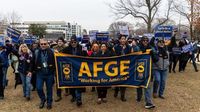As the United States marks the 30th day of a historic government shutdown, the impasse in Washington shows little sign of abating. With over a million federal workers going unpaid, food assistance for millions on the brink of collapse, and air travel disruptions mounting, the crisis is beginning to ripple through American life in ways both immediate and profound.
The standoff has become a test of political will between President Donald Trump, congressional Republicans, and Democrats, each side digging in as the consequences for ordinary Americans grow more severe. On October 30, 2025, President Trump returned from a high-profile trip to Asia, where he met with Chinese leader Xi Jinping and claimed to have reached agreements on tariffs and rare earth minerals. But upon landing back in the U.S., the president faced a deepening domestic crisis.
That evening, Trump took to social media with a forceful new demand: he called on Senate Republicans to eliminate the filibuster—invoking what’s known as the “Nuclear Option”—to pass the Republican funding bill and immediately reopen the government. “It is now time for the Republicans to play their ‘TRUMP CARD,’ and go for what is called the Nuclear Option -- Get rid of the Filibuster, and get rid of it, NOW!” Trump posted, according to ABC News. He laid the blame for the shutdown squarely at the feet of Democrats, writing, “DEMOCRATS HAVE GONE STONE COLD CRAZY.”
Trump’s frustration was palpable. Reflecting on conversations during his Asia trip, he recounted, “The question I kept getting was how did the Democrats SHUT DOWN the United States of America, and why did the powerful Republicans allow them to do it?” He added, “In flying back, I thought a great deal about that question, WHY?”
Yet, despite the president’s calls for drastic Senate action, not everyone in his own party is on board. Earlier in October, Senate Majority Leader John Thune rejected the idea of eliminating the filibuster, emphasizing the importance of Senate rules even amid crisis. Thune did, however, express hope for ongoing bipartisan talks, telling CNN he expects “members to continue talking over the weekend,” though he offered little optimism for a swift resolution.
Meanwhile, Democrats remain unmoved by mounting pressure from labor unions and the public. The American Federation of Government Employees (AFGE), representing more than 800,000 federal workers, renewed its call for lawmakers to pass a “clean” continuing resolution to fund the government and end the shutdown. “It’s time for our leaders to start focusing on how to solve problems for the American people, rather than on who is going to get the blame for a shutdown that Americans dislike,” said AFGE president Everett Kelley. “It’s long past time for our leaders to put aside partisan politics and embrace responsible government.”
But Democratic leaders, while sympathetic to the plight of federal workers, have held firm. Senate Minority Whip Dick Durbin acknowledged the union’s concerns, saying, “It has a lot of impact, and they’ve been our friends and we’ve worked with them over the years.” Yet, he added, “I’m not seeing any change in position at this time” as Democrats continue to insist that their concerns about rising health care costs be addressed before agreeing to reopen the government.
Other Democrats echoed this resolve. Sen. John Hickenlooper of Colorado remarked, “You’re damned if you do and damned if you don’t. I can’t remember a situation where I felt there were less palatable choices.” He continued, “I don’t feel comfortable with that, because I’m not convinced that, you know, sacrificing whatever it is, 30, 35 million people, who are going to either lose health care or pay dramatically more for it is worth that extra week, but it’s tough. Trust me, it’s a hard calculus to figure out.”
Republicans, for their part, have argued that Democrats are prolonging the suffering for political gain. House Speaker Mike Johnson has kept the House out of session since September 19, and Republican leaders have refused to negotiate on Democrats’ health care demands until the government is reopened. Sen. Cynthia Lummis of Wyoming told reporters it would be a “waste of time” for lawmakers to remain in Washington to work out a deal, blaming Democrats for the continued impasse and highlighting that Republicans have “bent over backwards, voted 13 times to try to open the government with current funding.”
The shutdown’s effects are being felt far beyond the halls of Congress. Food stamp benefits are set to lapse for millions of Americans over the weekend, with states like Maryland, Ohio, and North Carolina scrambling to patch together emergency funding for food banks and assistance programs. “People are really desperate to know where they can get access to this additional food,” said the president of the North Texas Food Bank, who noted a nearly 60% anticipated increase in demand due to the loss of SNAP benefits.
Air travel, too, is under strain. The Federal Aviation Administration reported severe air traffic control staffing shortages, resulting in average flight delays of more than two and a half hours at Orlando International Airport. Vice President JD Vance warned, “Look it could be a disaster. It really could be, because at that point you’re talking about people have missed three paychecks. They’ve missed four paychecks. How many of them are not going to show up for work?” Transportation Secretary Sean Duffy added, “Our traffic will be snarled, but it will be a disaster in aviation.”
As the shutdown drags on, the rift between Democrats and their traditional union allies has widened. On October 30, Teamsters president Sean O’Brien and Southwest Airlines Pilots Association president Jody Reven joined officials outside the White House to call attention to the growing pain among workers. The pressure on lawmakers is intensifying, but so far, neither side has budged.
President Trump, meanwhile, has faced criticism from Democrats for his handling of the crisis. They accuse him of prioritizing foreign aid proposals and overseas trips over resolving the domestic impasse. Vermont Sen. Peter Welch said, “Trump can take care of this if he pauses to make a phone call and allow us to reach the health care resolution.”
In a moment that captured the surreal juxtaposition of crisis and tradition, Trump and First Lady Melania Trump hosted a Halloween event on the White House South Lawn, distributing candy to families as the shutdown’s shadow loomed large. The president, fresh from his Asia tour, high-fived children dressed in costumes, even as millions of Americans faced uncertainty about their next meal or paycheck.
With both parties entrenched and the stakes rising for families across the nation, the question remains: what will it take to break the deadlock and bring relief to those caught in the crossfire of political brinkmanship?






